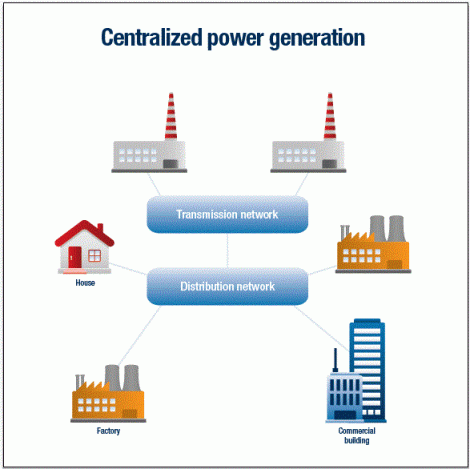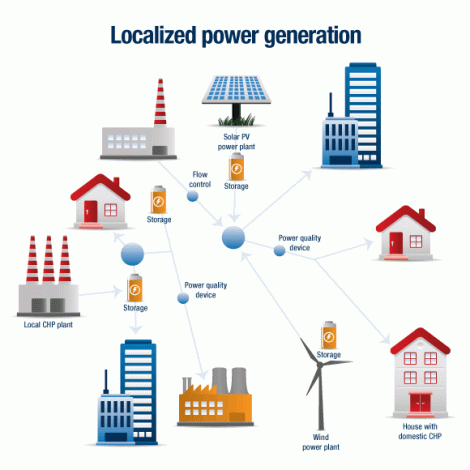The folks over at Platts have a feature on distributed energy called “the ghost in the machine.” That title is ironic, for reasons I’ll get into in a minute. Still, it’s great to see outfits like Platts taking note of this stuff. For a broad view of the same trend, check out my post on “the next big thing in energy: decentralization.”
Platts begins:
The wave of small-scale power generation technologies — technically known as distributed energy resource (DER) systems — that are growing in use or undergoing rapid development across Europe, from fuel cells to micro turbines, photovoltaic systems and reciprocating engines, do indeed point to a fundamental change in the way, and by whom, power is generated, transmitted and stored.
It’s not just about the power generation, of course, it’s also about storage, intelligent management, and demand reduction. It’s about creating a lean, resilient, just-in-time electricity system to replace the lumbering dinosaur we live with today.
The centralized paradigm, which still dominates, is simple. It’s a one-way street from generators to transmission to distribution to (passive) consumers:

PlattsClick to embiggen.
The localized paradigm is more complex, with power going every which way, via multiple technologies:
The transition from the former to the latter is going to scramble everything, not only the economics of power but the institutions, the regulations, the political landscape, the technology, and of course the carbon content. It’s going to be fun to watch.
So yeah, mainly I just wanted an excuse to post those graphics. But I know all of you are wondering, “Why is the title ‘ghost in the machine’ ironic?” Well, I’ll tell you!
“Ghost in the machine” is a derogatory term that British philosopher Gilbert Ryle used to refer to the mind-body dualism made famous by philosopher René Descartes. The idea — which still holds a strong intuitive appeal for lots of people, even today — is that there’s a body, a thing of the physical world, and an immaterial mind, which operates and oversees the body. The picture one got from Descartes was of a little man (a “homunculus”) inside the brain, gathering data from the body’s senses, interpreting it, and giving instructions for action. You know how, in spy or action movies, the guy running the nefarious government program is always standing in a room, surrounded by computers, barking things like “I want eyes on that warehouse!” and “move team A into position!”? That’s sort of how Descartes imagined the mind inside the brain — a homunculus integrating all the information and figuring out what to do. (The precise way that mind stuff can cause changes in physical stuff has always been a bit hazy, but leave that aside.)
Mind-body dualism has come under frequent attack ever since, but another aspect of Descartes’ vision has also fared poorly. It is the idea that intelligence/reason must reside in a singular seat of rationality (that homunculus). There must be a headquarters, a central control station, a nerve center, where info is gathered and decisions are made. The presence of that “seat of reason” is what sets humans apart from animals, which are governed by brute instinct.
When people first got into artificial intelligence — trying to make intelligent machines — this was the model they had in their heads. They built computers with huge central processors and fed them tons of raw facts. But over time, in the cognitive sciences, that model has gone out of favor. The new model is based on parallel, distributed processing. There is no center, no singular intelligence running things. Rather, there are comparatively “dumb” nodes — with limited processing power devoted to limited subroutines — networked together in a latticework of relatively simple, rule-governed interactions. Get enough of these nodes interacting and you get complex systems with emergent properties — properties of the system that are not reducible to the properties of its constituent parts. Consciousness and intelligence themselves are now generally seen as emergent properties of distributed neural processing systems interacting with physical and social contexts.
You’ll notice that this same transition, from centralization to distribution, from linearity to complexity, pops up in other places too. Democracy itself is an example. It was taken for granted for centuries that a populace with no singular, strong ruler would dissolve into chaos. But it turns out that self-organizing systems of distributed political power — even with the dumb nodes, and boy are there some dumb nodes — are generally healthier and more dynamic. Capitalism is another example. Central management of economies has generally failed to create prosperity; prosperity has tended to be an emergent property of economies that consist of rule-governed interactions among independent nodes. The IT revolution is another good example. The creation and distribution of information was once a highly bottlenecked process, governed by a few large entities, but now processing power and bandwidth have been put in everyone’s hands and things have been created that never could have been anticipated or planned by a single governing intelligence.
It’s the same transition that’s now happening in the power system. Rather than one central intelligence (a utility) predicting demand and directing investment, there are going to be thousands, nay millions, of dumb nodes, houses and buildings and cars and batteries and microgrids and whole communities generating and managing their own electricity based on local needs and preferences.
My prediction is that the familiar pattern will repeat itself: The transition from centralized to distributed power will produce more reliability, resilience, and intelligence than the clunky, top-down systems of the past.
Unfortunately, when it comes to power we have the central intelligences of the past, utilities, still very much alive, influential, and hostile to the notion of being overwhelmed by a leaderless swarm. They are actively inhibiting the transition and will likely continue to do so until they wither entirely. Der commissar does not submit peacefully to the rabble.
But the transition is inevitable. And that’s the irony: distributed energy is not a ghost in the machine. The ghosts, the homunculi, are being driven from the machine. Soon there will only be the machine and its emergent intelligence.





